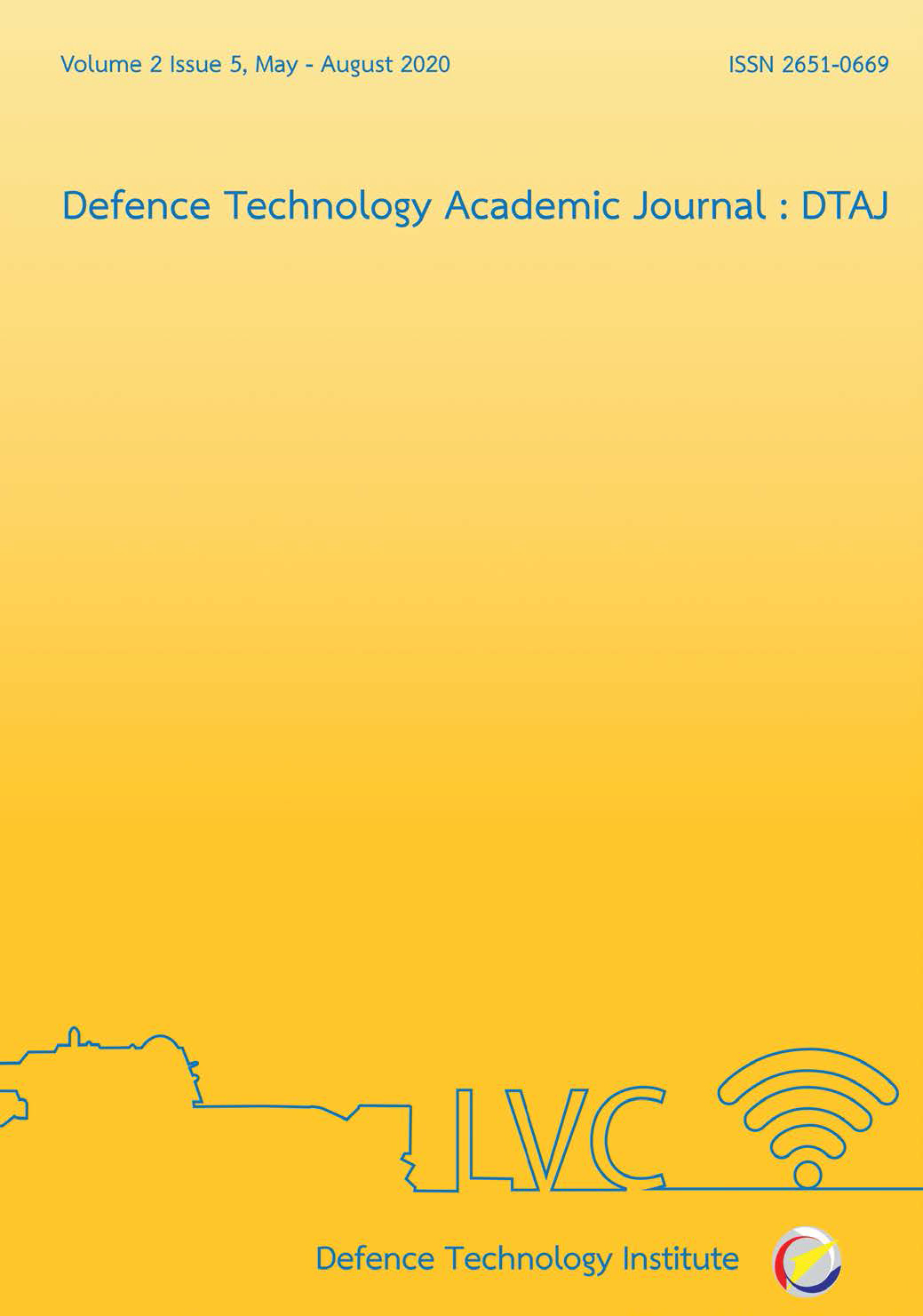การทดสอบภาคพลวัตระบบเซ็นเซอร์และระบบสื่อสารสำหรับจรวดนำวิถี
Main Article Content
บทคัดย่อ
บทความวิจัยฉบับนี้เป็นการแสดงผลทดสอบอุปกรณ์ฮาร์ดแวร์และซอฟต์แวร์ของเซ็นเซอร์และระบบสื่อสารที่เตรียมการสำหรับเทคโนโลยีจรวดนำวิถีของสถาบันเทคโนโลยีป้องกันประเทศ โดยอาศัยการทดสอบเบื้องต้นกับจรวดดัดแปรสภาพอากาศที่มีสมรรถนะน้อยกว่าจรวดนำวิถี โดยมีวัตถุประสงค์เพื่อทดสอบและตรวจสอบการทำงานของอุปกรณ์สื่อสารไร้สายแบบ Frequency Hopping Spread Spectrum (FHSS) ที่มีจำหน่าย 2 ชนิด ของระบบโทรมาตรที่นำมาติดตั้งกับลูกจรวด รวมถึงตรวจสอบการทำงานของอุปกรณ์อิเล็กทรอนิกส์และเซ็นเซอร์ ข้อมูลจากเซ็นเซอร์ Inertial Measurement Unit (IMU) และค่า Inertial Navigation System (INS) ที่คำนวณจากไมโครโพรเซสเซอร์ ที่ติดตั้งบนลูกจรวด จะถูกส่งข้อมูลผ่านระบบสื่อสารไร้สาย มาบันทึกข้อมูลไว้เพื่อใช้นำมาวิเคราะห์เปรียบเทียบผลการยิงทดสอบกับค่าจากการออกแบบลูกจรวดต่อไปและนำไปพัฒนาต่อยอดไปสู่ระบบนำวิถีของลูกจรวด
ผลการทดสอบปรากฏว่าระบบสื่อสารที่ใช้ทั้ง 2 ชนิด สามารถรับส่งข้อมูลได้ตลอดแนวขีปนวิถีและบันทึกค่าเก็บไว้ได้ ค่าความเร่งและความเร็วเชิงมุมที่วัดได้จากเซ็นเซอร์ IMU มีแนวโน้มใกล้เคียงกับค่าจากการจำลองที่เวลาเดียวกัน แต่เนื่องจากเซ็นเซอร์ที่ทำการติดตั้งไปกับจรวดมีย่านการวัดไม่สูงพอกับค่าสมรรถนะของจรวด ทำให้ค่าที่แสดงผลมีค่าแค่ค่าสูงสุดที่เซ็นเซอร์วัดได้ ซึ่งค่าความเร่งสูงสุดที่เซ็นเซอร์วัดได้มีค่า 30g และความเร็วเชิงมุมสูงสุดที่เซ็นเซอร์วัดได้มีค่า 4,000 องศาต่อวินาที โดยเมื่อทำการยิงทดสอบเมื่อจรวดมีค่ามากเกินกว่าค่าสูงสุดของเซ็นเซอร์ค่าต่าง ๆ จะถูกบันทึกได้แค่ค่าสูงสุดที่เซ็นเซอร์วัดได้ เมื่อนำค่าที่วัดได้มาคำนวณเทียบกับค่าจากการจำลอง พบว่าในช่วงต้นค่าระยะทางของจรวดและค่ามุมต่าง ๆ มีแนวโน้มใกล้เคียงกับค่าจากการจำลอง ซึ่งความคลาดเคลื่อนบางส่วนมีผลมาจากการติดตั้งเซ็นเซอร์ภายในลูกจรวดมีความเยื้องศูนย์และเซ็นเซอร์ยังไม่ได้ทำการปรับเทียบครบถ้วน และหลังจากค่าของจรวดมีค่ามากกว่าค่าสูงสุดของเซ็นเซอร์ การนำค่าที่วัดได้จากเซ็นเซอร์มาคำนวณจะทำให้ผลไม่ถูกต้อง
Downloads
Article Details

อนุญาตภายใต้เงื่อนไข Creative Commons Attribution-NonCommercial-NoDerivatives 4.0 International License.
Journal of TCI is licensed under a Creative Commons Attribution-NonCommercial-NoDerivatives 4.0 International (CC BY-NC-ND 4.0) licence, unless otherwise stated. Please read our Policies page for more information...
เอกสารอ้างอิง
ราชกิจจานุเบกษา (2562) พระราชบัญญัติเทคโนโลยีป้องกันประเทศ พ.ศ. 2562. เล่ม 136 ตอนที่ 56 ก. หน้า 17 – 38.
Blagojević, Đ. and Miloš, M. 2006. Outline design of compact GNC module for missile flight control purposes. FME Transactions (2006) 34, 137-143.
โครงการพัฒนาจรวดดัดแปรสภาพอากาศ. 2562. การพัฒนาระบบ TM-CAM สำหรับตรวจสอบการทำงานของจรวด. เอกสารออนไลน์ http://society.dti.or.th/DTIKMRocket1/Lists/K5/AllItems.aspx เข้าถึงเมื่อ 20 ก.ค. 63
โครงการพัฒนาจรวดดัดแปรสภาพอากาศ. 2562. การพัฒนาระบบ TM สำหรับตรวจสอบการทำงานของจรวด. เอกสารออนไลน์ http://society.dti.or.th/DTIKMRocket1/Lists/K5/AllItems.aspx เข้าถึงเมื่อ 20 ก.ค. 63
Han, F., Zhou, Q. and Chen, F. 2019. Dynamic modeling, simulation, and flight test of a rocket-towed net system. Mathematical Problems in Engineering. Volume 2019, Article ID 1523828, 21p. doi.org/10.1155/2019/1523828.
King, B., Eckert, C. and Minor, R. 2002. The International GMLRS Development Program - A GPS/INS application to extend the range and effectiveness of the basic multiple launch rocket system (MLRS). Proceedings of the 15th International Technical Meeting of the Satellite Division of the Institute of Navigation (ION GPS 2002) September 24 - 27, 2002 Oregon Convention Center, Portland, Oregon.
de Carpentier, G. J. P. 2014. Analytical ballistic trajectories with approximately linear drag. International Journal of Computer Games Technology. Volume 2014, 13p. doi.org/10.1155/2014/463489.
Fairfax, L. D. and Fresconi, F. E. 2012. Position estimation for projectiles using lowcost sensors and flight dynamics. U.S. Army Research Laboratory. Aberdeen Proving Ground, MD 21005-5066.
Scaysbrook, I. W., Cooper, S. J. and Whitley, E. T. 2004. A miniature, gun-hard MEMS IMU for guided projectiles, rockets and missiles. Position Location and Navigation Symposium. (IEEE Cat. No.04CH37556), Monterey, CA, USA, 2004, pp. 26-34. doi: 10.1109/PLANS.2004. 1308970.
Aziz, J. S. and Hussein, O. A. 2009. Design and Implementation of a Telemetry System for Environmental Applications. Al-Khwarizmi Engineering Journal, Vol. 5, No. 4, pp. 39-50.
Peng, W., Zhang, Q., Yang, T. and Feng, Z. 2017. A high-precision dynamic model of a sounding rocket and rapid wind compensation method research. Advances in Mechanical Engineering. Vol. 9(7) 1–11. Vol. 9(7) 1–11.
Liu, F., Su, Z., Zhao, H., Li, Q. and Li, C. 2019. Attitude measurement for high-spinning projectile with a hollow MEMS IMU consisting of multiple accelerometers and gyros. Sensors 2019, 19, 1799; doi:10.3390/s19081799.
Törnqvist, D., Helmersson, A. and Gustafsson, F. 2020. Tight integration between IMU and GPS for sounding rockets. Technical report from Automatic Control at Linköpings universitet. Report no.: LiTH-ISY-R-2929. Department of Electrical Engineering, Linköpings universitet, SE-581 83 Linköping, Sweden. 30p.
Albayrak, A. 2017. IoT-based Real-Time Telemetry System Design: An Approach. 2017 IEEE 5th International Conference on Future Internet of Things and Cloud (FiCloud). DOI: 10.1109/FiCloud.2017.40.


